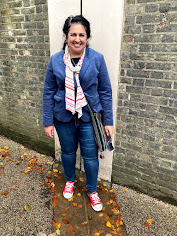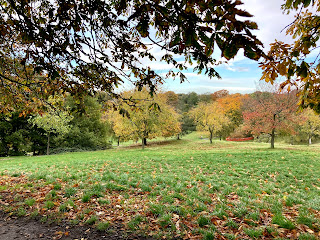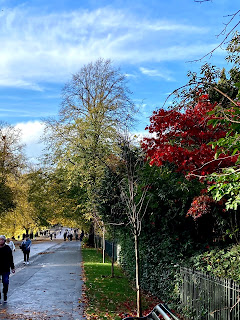I was reminded of this line today, and I couldn't remember where I'd heard it before, so I turned to good ol' Google to remind me. It's from the Kipling poem "The Ballad of the East and West." The first stanza is as follows:
0h, East is East, and West is West, and never the twain shall meet,
Till Earth and Sky stand presently at God's great Judgment Seat;
But there is neither East nor West, Border, nor Breed, nor Birth,
When two strong men stand face to face, though they come from the ends of the earth!
What does that have to do with today's post? Precious little, other than that I was at the centre of east and west today, and it so happens that Kipling is British, but that's a coincidence. Given that I'm in England, you might be able to guess where I went today if I'm talking about east and west: Greenwich.
 |
Steak & truffle fries for lunch
|
Initially, I went to Greenwich Market. My sister-in-law's sister has a stall there, but I forgot that she wouldn't be there today, so I ended up not getting to see her stall, but I did at least get to see a few others stalls and some places around the market, try some yummy food from local street stalls at the market, buy some soap from the market like the kind of soap I was using at home and didn't know where I'd find similar soap here, and be able to go to the Royal Observatory Greenwich, which is the place you go to see the spot marked "where time begins," as I like to call it.
Whenever you see time with GMT after it, that's Greenwich Mean Time, where the prime meridian runs through, meaning the longitude is 0º, and where, according to Wikipedia was for a long time used by over 2/3 of ships and tonnage as a reference point for their charts and maps. I mean, England was the centre of the universe for so long, right? Well, GMT was superseded by Universal Coordinated Time (UTC) in 1972, but I still see GMT quite commonly used. What's also noteworthy is that the prime meridian itself has also shifted slightly over time as the earth's crust moves, so the line that marks GMT may actually be off now.

|
The prime meridian through the gate
|
In any case, we didn't pay to go into the Observatory. There is actually lots to see around it, including the National Maritime Museum, which is free--though currently any museum that's open requires a booking, even if it's free, by way of controlling the number of people in it at any given time for the sake of physical distancing, and there is a beautiful park that surrounds the area. The only thing is that by not paying, you couldn't get in to see the meridian line, so I took a photo of it from through the fence. You can at least see it through a gate, just that you can't step over it and be on either side of it at the same time.
You would think that it would be a little disappointing not to get to actually step over or straddle that line, but for the very few of you who have followed by blog for years, you might remember how much I enjoy looking behind me when there's some sort of attraction in front of me. At the very least, you get an interesting perspective of the crowd, but sometimes you notice something that others don't see that can be just as interesting if not more, and is sometimes overlooked because a well-known attraction is stealing the limelight. The prime meridian is one of those things. We noticed that a family was going through an open gate with a pathway leading to some unknown destination around the Observatory. I went over to investigate and noticed that the same type of line that is marked above as the prime meridian and that is within the Observatory part for which you have to pay, actually extends down vertically and again horizontally, crossing that pathway. We went through the gate, and sure enough, the prime meridian is marked there as well--and it's completely free. I'm sure the Observatory is worth a visit, but if you're only going for a photo with the prime meridian, why pay all that money when you can get it for free! So I happily got my photo because I took the time to investigate the road less travelled. I should mention that as you might be able to see in the photos (I think you have to click on them to enlarge them) that east and west are marked on either side of the line. I guess that means I was in two of the earth's hemispheres at once!




The pathway leads to a garden on one side of the Observatory. There isn't much to see there, but the walk was refreshing with the smells of old-growth greenery after the rain, and the scenery was beautiful as the sun came out and created spots of colourful sparkles, lighting up the trees in all their autumnal glory. The park itself also has some trees with very thick trunks. I can't even imagine how old those trees must be, but I had to get photos of them. There was also a statue there of General Wolfe, who defeated the Marquis de Montcalm at the Battle of the Plains of Abraham. If you don't remember your Canadian history (I forgot who these guys were, too), you can
click this link to read more. What's interesting is that while the monument was gifted to the UK by Canada in 1930, it was the Marquis de Montcalm who unveiled it. It seems odd that a descendent of the defeated party would unveil a monument to the victor of that battle! We also walked down to Cutty Sark before we went home. I didn't actually know what that was, but it's some ship. I don't know the history of it to know why it's there or significant, but I honestly didn't have much interest in it. We were just curious what was over there. The boat looks really cool because my landlocked province at home would never house such a thing, so it's neat just to see such a massive boat and with a beautiful design.
I leave this post with photos of those scenes as well as that of the surrounding park--in the past I used to be able to create albums for these things on Blogger when it used Picasa, but unfortunately that is no longer possible now that Picasa is not supported, and Google failed to provide a good alternative to adding albums to one's blog. So I'll put them here in a way that will probably look somewhat messy due to the poor capabilities of this program.
 |
The tree is so massive, it collects pools of water
|





 The pathway leads to a garden on one side of the Observatory. There isn't much to see there, but the walk was refreshing with the smells of old-growth greenery after the rain, and the scenery was beautiful as the sun came out and created spots of colourful sparkles, lighting up the trees in all their autumnal glory. The park itself also has some trees with very thick trunks. I can't even imagine how old those trees must be, but I had to get photos of them. There was also a statue there of General Wolfe, who defeated the Marquis de Montcalm at the Battle of the Plains of Abraham. If you don't remember your Canadian history (I forgot who these guys were, too), you can click this link to read more. What's interesting is that while the monument was gifted to the UK by Canada in 1930, it was the Marquis de Montcalm who unveiled it. It seems odd that a descendent of the defeated party would unveil a monument to the victor of that battle! We also walked down to Cutty Sark before we went home. I didn't actually know what that was, but it's some ship. I don't know the history of it to know why it's there or significant, but I honestly didn't have much interest in it. We were just curious what was over there. The boat looks really cool because my landlocked province at home would never house such a thing, so it's neat just to see such a massive boat and with a beautiful design.
The pathway leads to a garden on one side of the Observatory. There isn't much to see there, but the walk was refreshing with the smells of old-growth greenery after the rain, and the scenery was beautiful as the sun came out and created spots of colourful sparkles, lighting up the trees in all their autumnal glory. The park itself also has some trees with very thick trunks. I can't even imagine how old those trees must be, but I had to get photos of them. There was also a statue there of General Wolfe, who defeated the Marquis de Montcalm at the Battle of the Plains of Abraham. If you don't remember your Canadian history (I forgot who these guys were, too), you can click this link to read more. What's interesting is that while the monument was gifted to the UK by Canada in 1930, it was the Marquis de Montcalm who unveiled it. It seems odd that a descendent of the defeated party would unveil a monument to the victor of that battle! We also walked down to Cutty Sark before we went home. I didn't actually know what that was, but it's some ship. I don't know the history of it to know why it's there or significant, but I honestly didn't have much interest in it. We were just curious what was over there. The boat looks really cool because my landlocked province at home would never house such a thing, so it's neat just to see such a massive boat and with a beautiful design.


















